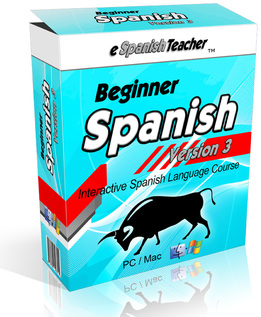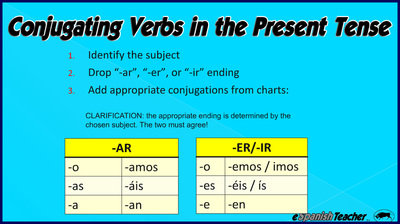|
Here is a summary of 25 important verbs all Spanish speakers should learn as early as possible. If you are equipped with a small number of important Spanish verbs, you'll be surprised how much you can actually say. Learning these is a much more effective approach than simply memorizing a few phrases to get around town.
Remember that you'll receive the eSpanishTeacher 101 Spanish Verbs course when you purchase our Beginner Spanish course. This course will teach you to use the 101 most common verbs in the entire Spanish language and you'll get plenty of practice speaking out loud. Learn Spanish on Amazon Learn Spanish on eBay Learn Spanish on Groupon Learn Spanish online with Udemy  After six months of planning, design, & development, we are pleased to announce the launch of our revised & refreshed Beginner Spanish Version 3! The team at eSpanishTeacher is extremely proud of this product and know that our customers will love it too. Boasting improved audio, more effective visuals, more comprehension exercises, and 4 brand new lessons, Beginner Spanish Version 3 is the complete package for folks wanting to learn to speak Spanish quickly. And like previous offerings, Version 3 ships with 101 Spanish Verbs as a free bonus! So you get even more great Spanish instruction in a personalized setting with from an actual Spanish teacher for the same great price. That's right, we're giving you more language learning content without increasing the price. This is a no brainer for people wanting to learn Spanish or brush up on speaking skills you haven't used in some time. Past customers have told us that the course also works for younger audiences. So don't wait any longer. Click here to start learning and speaking Spanish today!  "Poder" is one of the most common verbs in the Spanish language. It's perhaps the most important verb for you to know. It means "to be able to" or "to can" (I can..., she can..., they can...). If you turn on a Spanish TV channel like Telemundo or Univision, you'll hear various usages of "Poder" in nearly every sentence. A few examples: Si se puede = yes you can Se puede [insert verb here] = You can ... Tú lo puedes hacer = You can do it There's a common usage of "Poder" that will help you be a more refined Spanish speaker that I want to cover today. Lots of people will say things like: Podemos trabar para tí = We can work for you ¿Puedes darme el libro? = Can you give me the book? Usted puede venir conmigo = You can come along with me These statements are a result of the speaker attempting to translate directly from English to Spanish. It can be tempting to do this and in many cases it's fine. And I want to be clear that the examples above are not incorrect, rather there are better ways to communicate the three statements above without using "Poder". Try this instead: Trabajamos para tí = We'll work for you ¿Me das el libro? = Will you give the book to me? Tu vienes conmigo = You come along with me (this is good because it's not quite a strong as the command, "Ven conmigo") The point of this post is that while "Poder" is one of the most fequently used verbs in Spanish, sometimes English speakers have a tendency to overuse it. So if you ever find that you're saying things like ¿Puedes ayudarme? = Can you help me? Puede ella tocar el piano? = Can she play the piano Stop and think for a minute how you might say it without using "Poder" ¿Me ayudas? = Can you help me? ¿Toca ella el piano" = Does/can she play the piano? Supplemental to the above, here is the spanish conjugation for Poder: Poder = To be able to / To can Yo puedo = I can Tú puedes = you can Él puede = he can Ella puede = she can Usted puede = you can (formal) Nosotros podemos = we can Vosotros podéis = you guys can Ellos pueden = they can (group of males or mixed gender) Ellas pueden = they can (group of females) Ustedes pueden = you all can  Perhaps one of the most common questions for Spanish teachers from their students is how to determine when to use Ser and when to use Estar. Because both verbs mean "to be", it can be a very difficult concept to fully understand. I've created the graphic below to help you understand the difference between ser and estar and when to use each verb. I dive into this topic in more detail in my Beginner Spanish course. Let me know what you think of this graphic. I've started using more visuals like this to teach Spanish and have been getting very good feedback. Hablar is a common Spanish verb that means "to speak" or "to talk". It's a very simple -AR verb and likely one of the very first verbs you would learn in any beginner level Spanish class. Here is how to conjugate the verb hablar:
Yo hablo - I speak Tú hablas - You speak (informal) Él habla - He speaks Ella habla - She speaks Usted habla - You speak (formal) Nosotros hablamos - We speak Vosotros habláis - You guys speak/ You all speak (informal) Ellos hablan - They speak (group of males or group of mixed gender) Ellas hablan - They speak (group of females) Ustedes hablan - You all speak / You speak (formal) A few examples using hablar, translated from Spanish into English: Ellas hablan con los chicos. - They speak with the boys. Yo hablo por teléfono con mi madre. - I talk on the telephone with my mother. Ustedes hablan todos los días. - You talk every day. Another common Spanish verb is "Abrir", which means "to open". Pretty basic as a verb, but very common. Here's how it works.
Yo abro = I open Tú abres = You open Ella abre = She opens Él abre = He opens Usted abre = You open (formal) Nosotros abrimos = We open Vosotros abrís = You guys open Ellas abren = They open (group of females) Ellos abren = They open (group of males or mixed) Ustedes abren = You all open (formal) Here is how it works in real life: Nosotros abrimos la puerta. = We open the door. Él abre el libro. = He opens the book. Yo abro mi corazón. = I open my heart. Ellas abren sus bolsas. = They open their bags. One verb that should become part of your vocabulary very quickly is poder. Poder is the Spanish verb that means to be able to. This might not sound like the typical Spanish verb to you and you'd be right. It's not easy to image poder like is to run, to eat, to write. Some verbs are very visual and can be imagined easily. Poder is not one of these. It actually falls into the category with other vague verbs such as to have, to be, to know, etc. Another way to look at is is that poder is the verb that means to can, such as I can, she can, you can.
You may have heard the phrase Si, se puede, which comes from the verb poder. Essentially this phrase means Yes, you can or You can do it! It's common in Spanish to have someone say this as a form of encouragement. Here is a breakdown of how the verb is conjugated and it's translations into English: Yo puedo - I can Tú puedes - You can (informal) Él puede - He can Ella puede - She can Usted puede - You can (formal) Nosotros podemos - We can Vosotros podéis - You guys can (informal) Ellos pueden - They can (group of men or mixed) Ellas pueden - They can (group of women) Ustedes pueden - You all can (formal) When the verb poder is used, it is typically followed by another verb. This is because we normally say You can [verb], like in You can run, You can eat, You can write. So in Spanish, you'll want to follow the conjugated form of poder with an unconjugated verb. To see what I'm saying, here are some examples of sentences using the verb poder: Usted puede hablar. = You can speak. Nosotros podemos tocar la música. = We can play music. Yo puedo cantar. = I can sing. Vosotros podeís estudiar. = You guys can study. "Ser" is perhaps THE most common verb in the Spanish language. In my Beginner Spanish course I explain that there are two types of verbs: simple and vague. The simple verbs are simple to understand because you can visualize them easily. These are verbs like "to run", "to play", "to eat". You can easily visualize someone running, playing, or eating. But the other type of verb, the vague verbs, are not as easy to understand because they don't have such a visual meaning. "Tener" as is "Ser". It just so happens that some of the most common Spanish verbs--to have, to be, to do, to know--are vague verbs. This is important to know as you learn all about Spanish verbs, but don't worry as it will come easily as you study the language and practice speaking Spanish.
The true meaning of "Ser" is "To be", however, the easier way to remember it is to think of it as the I am, you are, she is verb. It literally is the verb used to communicate is, are, and am. This is how the verbs is conjugated: Yo soy - I am Tú eres - You are (informal) Él es - He is Ella es - She is Usted es - You are (formal) Nosotros somos - We are Vosotros sóis - You all are (informal) Ellos son - They are Ellas son - They are (group of females) Ustedes son - You all are (formal) Here are some examples of phrases using the verb "Ser": Yo soy maestra. - I am a teacher. Tú eres bondadoso. - You are kind. Nosotros somos estudiantes. - We are students. Es la una. - It's one o'clock.  This blog post is kicking off my new series on the most common Spanish verbs. These posts will contain useful and relevant help to all of you out there who are beginning to speak Spanish. Please let me know if there are verbs you'd like me to review. In Spanish verbs end in -AR, -ER, or -IR. Remember that verbs are action words. I have a unique perspective on Spanish verbs that I explain in depth in my Spanish course. I believe there are two types of verbs, simple and vague. First, the simple verbs are easy to imagine or visualize in your mind. It's easy to picture someone running, eating, or talking. And sure enough, to run, to eat, and to talk are all verbs. These are examples of the simple verbs and include nearly all verbs. The second group is what I refer to as vague Spanish verbs, or the verbs that are more difficult to imagine. Unfortunately, these are the most common verbs that are used multiple times in nearly every string of communication, such as to be, to have, to exist, and to be able to. The mastery of verbs--both simple and vague--comes with listening, practice, and confidence. For this post, I thought I'd address one of my favorite verbs, tener. Tener means 'to have' in Spanish, and you can use it to say things like "I have a meeting", or "You have to go", or "She has a pet cat". Here is a breakdown of the verb tener in the present tense: Yo tengo - I have Tú tienes - you have (informal) Ella tiene - she has Él tiene - he has Usted tiene - you have (formal) Nosotros tenemos - we have Vosotros tenéis - you guys have (informal) Ellos tienen - they have Ellas tienen - they have (group of females) Ustedes tienen - you all have (formal) Some examples of phrases using tener: Yo tengo un amigo - I have a friend Nosotros tenemos que ir - We have to go Ella tiene una cita - She has an appointment Tener is perhaps one of the top 3 verbs used in the Spanish language, so get used to it, memorize it, and start loving it! |
AuthorThis is where we chat about all things Spanish. Feel free to ask a question, challenge me, passionately disagree, or rant about whatever. Just make it interesting. Archives
August 2018
Categories
All
|








 RSS Feed
RSS Feed
